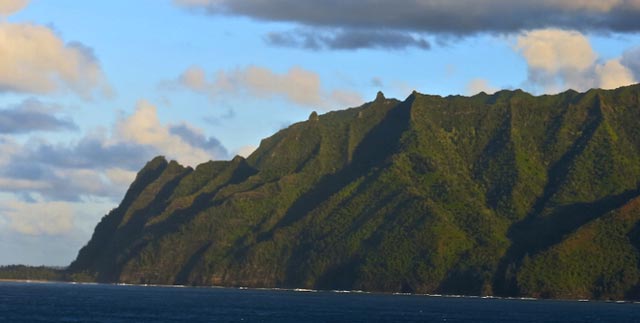
“You call someplace paradise / kiss it goodbye”
– Don Henley, “The Last Resort”
A Merger of Mutating Embodiments
For the past few years, my partner and I have been spending a significant amount of time on the island of Kaua’i. My mother-in-law and her partner are 20-plus-year residents of the Hawaiian Islands and have lived on Kaua’i since 2009. Prior to our recent series of return visits, we spent much of our time travelling in Europe, Central America, Canada and Asia during semester breaks and summers. The point is that choosing a spot to re-frequent such as Kaua’i is a shift in our travel practices and this change suggests something powerfully alluring about the island itself.
The island of Kaua’i is the oldest formation in a Hawaiian chain of land formations that is composed of more than 135 islands. Most of us know the “big six”: Big Island (Hawaii), Oahu, Maui, Molokai, Lanai and Kaua’i, but the geography proves much more diversified than this group of more recognizable island names suggests. Kaua’i is a “red dirt” island due to the rich iron content of the volcanic soil formed from decomposed basalt. The island is the only one in the Hawaiian chain formed by the melding of two separate massive volcanic eruptions that merged together to make the island of Kaua’i today. It is also the oldest and northernmost island in a chain, which has been more than 60 million years in the making (relatively young in geologic time particularly given that Polynesian migrants didn’t discover and settle the islands until 300 to 800 CE).
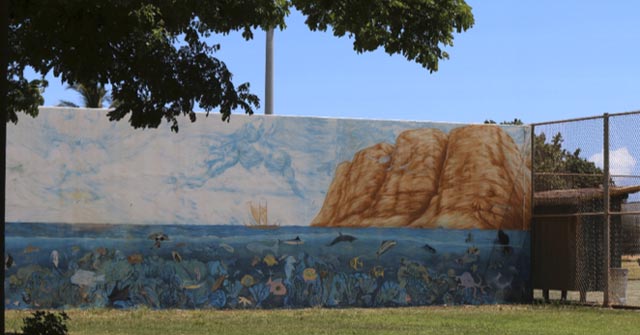 Waimea community mural depicting first Polynesian explorers coming to Kaua’i. (Photo: Sharon Snyder)
Waimea community mural depicting first Polynesian explorers coming to Kaua’i. (Photo: Sharon Snyder)
In James Michener’s novel Hawaii, he poetically describes the uniqueness of Kaua’i by referencing the originality and wildly mutating productiveness of its nature: “There was then, as there is now, no place known on earth that even began to compete with those islands in their capacity to encourage natural life to develop freely and radically up to its own best potential. More than nine out of ten things that grew here, grew nowhere else on earth.” This theme of productive mutation strongly represents why we find the island so appealing as scholars and as disabled people. It spurs our creativity and enfolds our diverse, mutating embodiments in ways that few other places can do.
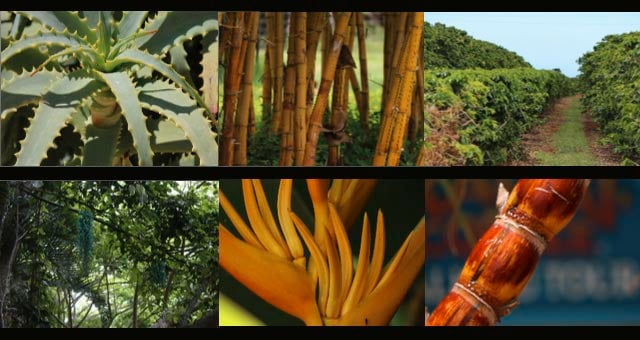 Images of Kaua’i’s diverse flora: 1) Hibiscus [hibiscus rosa-senensis], 2) Yellow Bamboo [phyllostachys aureosulcata], 3) Bird of Paradise [strelitzia reginae], 4) Jade Vine [strongylodon macrobotrys], 5) Ke’anae Heliconia [heliconia psittacorum hybrid], 6) Torch Ginger [etlingera eliatior/’awaphi ko’oko’o], 7) Ixora [ixora chinensis], 8) Impatiens [impatiens walleriana], 9) Pink Ginger [alpine purpurata]. (Photo: Sharon Snyder)
Images of Kaua’i’s diverse flora: 1) Hibiscus [hibiscus rosa-senensis], 2) Yellow Bamboo [phyllostachys aureosulcata], 3) Bird of Paradise [strelitzia reginae], 4) Jade Vine [strongylodon macrobotrys], 5) Ke’anae Heliconia [heliconia psittacorum hybrid], 6) Torch Ginger [etlingera eliatior/’awaphi ko’oko’o], 7) Ixora [ixora chinensis], 8) Impatiens [impatiens walleriana], 9) Pink Ginger [alpine purpurata]. (Photo: Sharon Snyder)
In her characteristically succinct yet understated and mildly ironic style, the writer Joan Didion once wrote that land formations such as those that make up the South Pacific islands are “a transitional accommodation to stress . . . and therefore every erosional landmass along the Hawaiian Ridge – is a temporary feature, and every rainfall or tremor along the Pacific plates alters its shape and shortens its tenure as the Crossroads of the Pacific.” This strange mix of antiquity, originality of flora and fauna, while exuding reminders of geologic temporality, work in combination with each other to create the uncanny features that make this island so seductive. The odd geographical pastiche makes for fertile conditions that promote reading and writing (arithmetic is performed mostly by the accountants of agribusiness – more on this below). These catalyzing forces comprise another reason why this place has become so magical for those of us who visit frequently.
Of Island Chains and Food Chains
Another reason for our investment in the island of Kaua’i involves the fragility of the ecosystems here. They serve as a frontline indicator of ways to protect and destroy the environment in which we humans and non-humans live in communion with each other in the complex interplay of organic and inorganic matter. Upon arriving on the island this summer, my partner’s mother, a member of the citizen activist group Kaua’i Rising, sent us an article about genetically modified (GMO) corn against which (along with voluminous pesticide sprayings and sonic soundings) much of local Kaua’ian culture struggles. The article ended with the following worrisome characterization of an environment teetering on the edge of unsustainability: “The chemical companies continue to dump one thousand pounds of toxins on Kaua’i every day, seven thousand pounds per week, and 30,000 pounds per month.” As a key site for agribusiness’ experimental farming exploits, Kaua’i represents both an example of a wildly natural environment as well as a toxic dumping ground for corporate despoliation. Perhaps the only damaging anti-eco business left to come is fracking. While it may seem completely counterintuitive for fracking to come to a volatile geographical area such as the Pacific Rim, I submit that the high-pressure practice is already occurring in equally unstable zones such as along the Pacific Ocean’s Monterey Shale and in California on the San Andreas Fault.
 The main entrance to Dow agribusiness on the east side of Waimea is nestled between a pre-school and a low-income housing project. (Photo: Sharon Snyder)
The main entrance to Dow agribusiness on the east side of Waimea is nestled between a pre-school and a low-income housing project. (Photo: Sharon Snyder)
Allowing the petition to go to a vote would give people who live on the island affected by GMOs and the attendant pesticide spraying too much say in how corporations manage their privately owned lands.
Imagine the overwhelming impact of this practice of dumping toxins on an island with a diameter of only 562.3 miles. Queer linguistic theorist Mel Chen’s claims in Animacies to the inevitability of our living with the strangely mobile inorganic compounds of toxicity notwithstanding, I tend to find myself agreeing more fervently with scholars such as Stacy Alaimo (Bodily Natures) who find that citizen activists and activist scientists tend to supply the siren call for encroaching toxicity dangers. There is rarely empirical proof to back toxicity claims by people living within harm’s throw of corporate and state-sponsored practices that destroy the environment and threaten organismic health on the planet. Yet without those alarms, the glacial nature of evidence that things we are doing to the environment resound with catastrophic results for all go unheeded in times of relatively unfettered exploitation of natural resources; this is ground zero for neoliberalism.
The odd particularities of neoliberal governing tactics came to mind for many of us on the island when it turned out that the County Council of Kaua’i illegally blocked a petition signed by more than 8,000 residents to stop GMO development by the likes of Monsanto, Dow agribusiness, BASF (yes, your old cassette tape manufacturing company), and Syngenta, among others. Historically, petitions that receive the requisite number of signatures go directly to ballot without interference because they represent the purest expression of the will of the people. Thus, four of the seven councilpersons (Furfaro, Yukimura, Kagawa, Rapozo) employed an unprecedented abuse of power to keep the will of the people from reaching a simple vote by the larger population. The reason given for the unprecedented blockage (when reasons were given) was that the petition for amendment potentially encroached upon the rights of agribusiness to decide its own practices. Allowing the petition to go to a vote would give people who live on the island affected by GMOs and the attendant pesticide spraying too much say in how corporations manage their privately owned lands.
Of course, such a contention to block the petition was exactly the point of holding a signature drive to get it on the November ballot. Thus, Council used the very logic of a peoples’ petition to undermine its viability for consideration by the wider Kaua’i electorate. Further private contacts with the councilpersons, including Furfaro, to ask what they thought they were doing in exercising such an abuse of power were met with either silence or a contention that they were supporting Bill 960 under consideration in Honolulu federal court. Bill 960 involves a court case brought by private agribusiness lawyers to prevent local municipalities (such as Kaua’i) from exerting power over how agribusiness uses land that it leases from a private school company established exclusively for privileged native Hawaiian students. In other words, one petition to block further GMO development until the corporations can prove their product neither harms people nor animals was toppled by another bill at the federal level to prevent such petitions from exerting a people’s governance over the use of local lands.
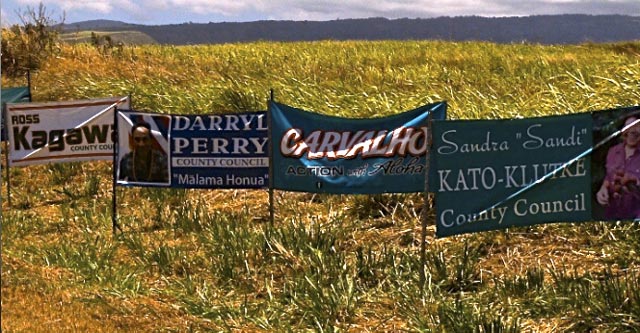 Politicking for votes in Poison Valley by Kaua’i County councilpersons supporting GMO. (Photo: Sharon Snyder)
Politicking for votes in Poison Valley by Kaua’i County councilpersons supporting GMO. (Photo: Sharon Snyder)
These are the new machinations of neoliberalism that govern by paving the way for corporate markets rather than on behalf of the people.
GMO = Plant Fracking
What’s at stake in this contest of political procedural antagonisms regarding the development of GMO crops and pesticide usage? First, according to agribusiness proponents – i.e. privately paid spokespersons, scientists and lawyers – the creation of GMO seedlings will make future generations of crops more resistant to harmful insect infestations and thus exponentially reduce the need for pesticide applications to preserve them from such incursions of nature. This rationale suggests that increasing the use of insect resistant crops will decrease environmental toxicity due to lowered need for pesticide use as an inoculating agent. Essentially, GMO creation involves taking the DNA from one organism and force-splicing it into another organism in order to create a third organism that has never existed on the planet. This process bypasses the millions of years that govern mutation in the making of today’s organic ecosystems. GMOs could be understood as the hybrid-manufacturing plant equivalent to fracking for oil on land in that they both represent imposing a powerful will upon the direction of nature.
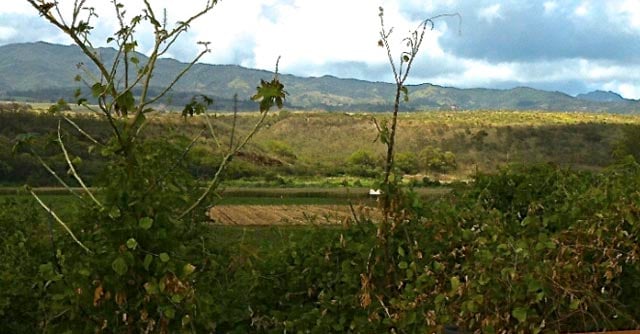 Dow’s GMO development test fields referred to as “poison valley” by its nearby residents. (Photo: Sharon Snyder)
Dow’s GMO development test fields referred to as “poison valley” by its nearby residents. (Photo: Sharon Snyder)
Agribusiness strategically employs the slow-paced nature of empirical validation practices as a way to invalidate individual and citizen-activist groups’ abilities to claim harm in the present and seek appropriate policy or financial remedies to curb corporate poisoning activities.
In contrast, citizen-activist groups attempting to end or delay GMO development argue that the impact of genetically altered food on human and non-human organisms have not been proven safe. In fact, the GMO testing fields (referred to by local residents as the “poison valley”) of a small, fragile ecosystem such as Kaua’i witness an excess of toxic pesticide dumping as the agribusiness companies develop their mutant resistant crop strains, which they package with pesticides and test for “virility” by spraying by the millions of pounds. An outcry was raised in 2007 when children attending a Waimea Canyon Middle School on the island’s south side (where GMO and pesticide testing fields are located) had to be sent home for health complaints such as asthma, burning throats and eyes, headaches and other allergy-like reactions after a chemical test cloud came through the windows of their classroom. Residents believed these symptoms were brought on by exposure to excessive pesticide usage while, in turn, the agribusiness companies argued the allergic reactions were caused by an outbreak of stinkweed in the area.
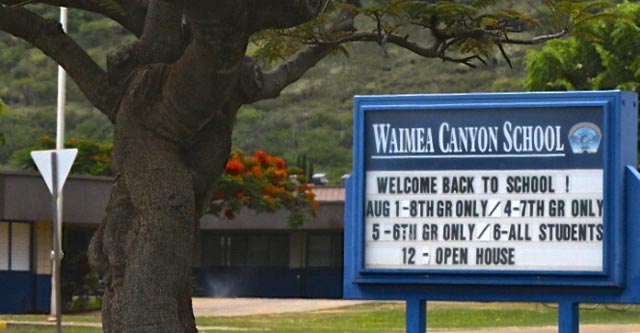 Waimea Canyon Middle School reported a cloud of pesticides from the GMO fields in 2007. (Photo: Sharon Snyder)
Waimea Canyon Middle School reported a cloud of pesticides from the GMO fields in 2007. (Photo: Sharon Snyder)
Part of the problem posed by arguments made in opposition to GMO development by groups such as Kaua’i Rising is that direct cause-and-effect links between genetically altered crop development, pesticide sprayings and rising environmental toxicity levels are difficult to prove without reliable longitudinal empirical evidence. This is because neoliberalism’s emphasis on governing on behalf of markets makes it increasingly difficult to trust citizen accounts “as evidence” regarding their experiences of toxic environments. Such arguments are easily pushed aside by paid expert dismissals arguing on behalf of the safety of agribusiness exploits. In this way, neoliberalism severs the ability to make connections between corporate behavior toward the environment and population-based demographic claims regarding toxicity’s fallout. The two domains are disallowed from referencing each other. In other words, agribusiness (as seen, for instance, in the decades-long resistance to accepting well-recognized links between cancer and tobacco usage by the tobacco industry) strategically employs the slow-paced nature of empirical validation practices as a way to invalidate individual and citizen-activist groups’ abilities to claim harm in the present and seek appropriate policy or financial remedies to curb corporate poisoning activities.
Yet, even in the face of the relatively slow pace of developing scientifically reliable evidence about the harmful effects of GMOs, recent studies have begun to validate the concerns of citizen complaints about rising toxicity levels. For instance, a study released by researchers at the University of Washington and published in Environmental Sciences Europereports that between 1996 and 2011, evidence demonstrates that the cultivation of insect resistant crops actually led to an increase in pesticide usage. Roundup modified crop development has, perhaps counterintuitively, accelerated pesticide use by 7 percent due to the need to combat “superweeds” that develop an immunity to commonly used herbicides and grow in GMO crop fields. Further multiple studies on the effects of glyphosate and atrazine mixtures used in the creation of GMO crops (commonly referred to by locals as the “Kaua’i cocktail”) make significant links between accelerated patterns of tumor growth, kidney disease, Hodgkin’s Lymphoma, and long-lasting unsafe toxicity levels in human and non-human animals living in the primary GMO development zones. This information belies the fact that GMO development companies such as Monsanto, Dow Agribusiness, and DuPont Chemical have claimed that their herbicide compound (Roundup) cannot be found in human and non-human organisms because it binds tightly to the soil and therefore is not available for uptake in plant root systems nor will it find its way into nearby water tables.
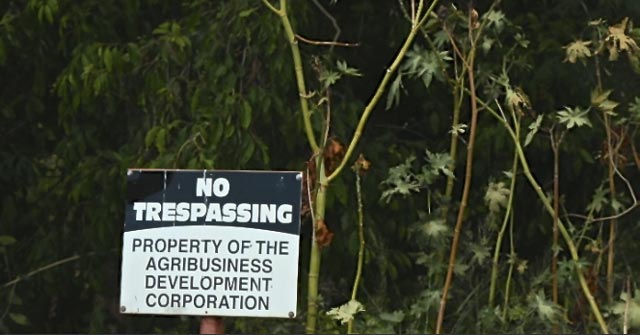 The circumference of the GMO “poison valley” is posted with “No Trespassing” signs. (Photo: Sharon Snyder)
The circumference of the GMO “poison valley” is posted with “No Trespassing” signs. (Photo: Sharon Snyder)
To place a GMO label on the package of any food is equivalent to placing a “skull and crossbones” there.
Not only does Monsanto dispute the likelihood of plant root uptake and waterways runoff claims, but they also argue the insecticide acts on an enzyme (EPSP synthase) that does not occur in people or animals. Yet, the herbicide has been found to affect other enzyme systems that are found in human and animal populations and therefore the discounting of one enzyme cannot be generalized to the discounting of the impact on other related systems. These built-in pesticide-based fortification systems for plants such Bt boosters and Roundup also serve another important function. In 2000, Roundup was about to expire as a patentable treatment and, in order to keep their corner on the market, Dow began developing Roundup Ready Seeds in order to tolerate large doses of the weed killer. This development process is part of the reason why GMO fields in Kaua’i can empirically be called “poison valley.”
The companies now sell their seeds and herbicide treatments as a package and farmers are forced to use one product if they use the other. The seeds are sold at relatively low prices because the profit exists in the pesticide treatment to accompany them. One Kaua’i resident has commented that this approach is similar to Hewlett-Packard selling its printers on the cheap because the profit is located in expensive inks needed for readable printer output. Thus, the pairing of GMO seeds with their pesticide companions has resulted in an increase of 527 billion pounds of herbicide applications worldwide over the first 16 years since GMO crop development began. Researcher Jeffrey Smith explains the toxic fallout of such practices: “It [herbicide] is found in the water supply, in the urine of city dwellers in Germany, in the blood of pregnant women in Canada and in their unborn fetuses. It is creating a disaster on Earth.”
A Brief Interlude on Disability as Evidence of Toxicity
One common element in all studies of pesticide toxicity on which I have not yet commented involves alarms about rising numbers of common disability mutations in GMO proximate populations. These studies reveal that an escalation in severely disabling conditions such as spina bifida, microtia, cleft lip and palate, polycystic kidney disease, and Down Syndrome have been documented in Chaco, Argentina, for instance, where GM soy planting and heavy glyphosate applications occur.
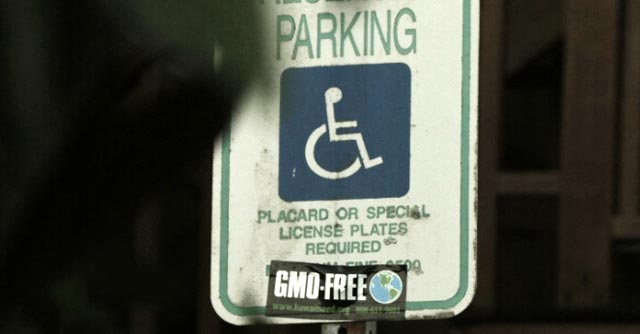 Not all combinations of the anti-GMO movement and disabled peoples’ lives prove productive. (Photo: Sharon Snyder)
Not all combinations of the anti-GMO movement and disabled peoples’ lives prove productive. (Photo: Sharon Snyder)
In instances of disability-based claims such as these, my own suspicions are raised. As a disability studies scholar, I incline toward inserting a cautionary note into these expressions of concern about disability as an indicator of escalating toxicity levels. When such evidence is brought forth, it effectively places disability in the role of a toxicity harbinger of disasters to come, particularly given that stories of congenital malformation so often subtend these discussions as anecdotal evidentiary claims. Visual sightings of cancerous tumors and “deformed” animal births underwrite many of the spectacular alarms raised by local Kaua’i hunters interviewed by concerned citizens. For instance, The Garden Island article cited earlier ends with a millenarian-like conclusion based on diseased animals occupying the Kaua’i wilds: “[a local hunter] shared with me that he and his fellow hunters are concerned because they are finding that the pigs and goats that they are now harvesting are often filled with tumors, both externally on their skin, and internally, and that they have to just leave them where they died as fertilizer.” Such developments are extremely worrisome if true with respect to GMO pesticide poisoning, but they also redound with age-old disability-laced fears as material evidence of corporate greed.
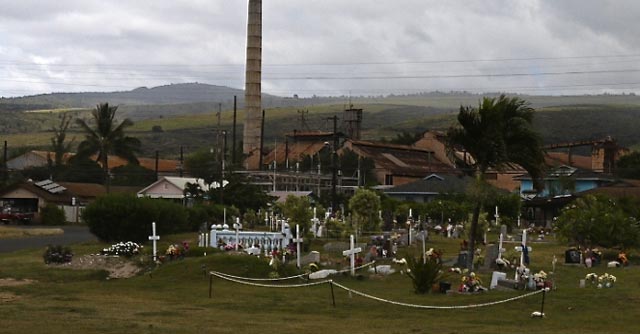 Waimea cemetery and smoke stack with “poison valley” in the background. (Photo: Sharon Snyder)
Waimea cemetery and smoke stack with “poison valley” in the background. (Photo: Sharon Snyder)
Conclusion: What’s In A Label?
So where do we stand in relation to GMO development and the citizen-scientist chronicling of its harmful effects? According to journalist Ronnie Cummins who has pioneered some significant exposés of the agribusiness industry, there are three basic principles with which we need to struggle. First, we must begin to reckon with the mounting scientific evidence that GMO food and crops as well as the pesticides used to develop them are hazardous to people and animals. Second, GMOs remain an ideological foundation stone to the cultivation of an increasingly poisoned food chain that now predominates in many agricultural and industrialized geopolitical zones of the world where agribusiness works its magic. Third, fraudulent labeling practices such as “natural,” “all natural,” and even “almost organic” allow manufacturers to mislead the public into thinking it is buying nutritious alternatives that are often at the forefront of environmental toxicity. Beyond these important facts about GMO production, it is also important to understand that in Europe where GMO labeling is mandatory, GMO-based agribusiness has been almost completely run off the grocery store shelves. To place a GMO label on the package of any food is equivalent to placing a “skull and crossbones” there – as one industry executive for Monsanto explained nearly 20 years ago.
This significant consumer market impact is exactly the reason why Bill 960 in Honolulu and the Kaua’i Rising Charter amendment petition to limit GMO-based food production until agribusiness produces evidence of the safety of their products are being fought so vigorously by corporate lawyers and lobbyists at the federal, state and local levels. These grassroots activist measures threaten state and private industry efforts to preserve profit at the expense of people and other organisms with which we share the environment.
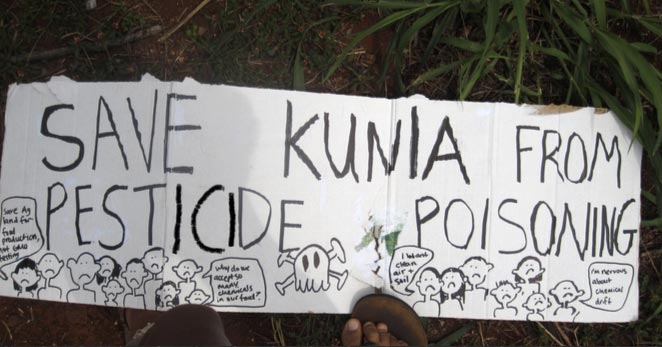 People’s protest against the GMO’s industry’s “poisoning of paradise” posted on a fence in Kilauea. (Photo: Sharon Snyder)
People’s protest against the GMO’s industry’s “poisoning of paradise” posted on a fence in Kilauea. (Photo: Sharon Snyder)
During our most recent visit to Kaua’i, two citizen-activist groups, the Center for Food Safety and Hawaii Seed, co-hosted presentations by doctors from the Philippines who have been working on the effects of GMOs and pesticides in human beings. One of the speakers, Romeo Quinjano, identified pragmatic steps for combatting the effects of the GMO industry: 1) make agribusiness prove that what it’s doing is safe, the precautionary principle; 2) expand monitoring of GMO spread and the accompanying toxins at the local, state and federal levels; 3) fund independent scientific studies that are not financed by the financial interests of agribusiness; 4) continue to recognize people power as the frontline fortification against unmitigated agribusiness expansion (Kaua’i Rising). Somewhat sobering, these recommendations almost exactly mirrored the recommendations identified in the Charter amendment that the Kaua’i County Council recently blocked upon presentation of the requisite 8,000-plus signatures to move the petition forward to the ballot in November as Charter Amendment Article 33.
Without these efforts to combat agribusiness’ intentions to make docile citizens complicit in their poisoning campaigns “from above,” there is little hope of refuting misinformation “from below.” Corporations often disparage citizen knowledge of their bodies and the relations they posit to environmental contaminants as ill-conceived. The case of Kaua’i citizens against the GMO industry is indeed “ill conceived” in the sense that people’s bodies are going awry in the onslaught of chemicals being introduced into their environments. This “felt knowledge” of harm “from below,” as Nikolas Rose puts it, “pluralizes biological and biomedical truth by introducing doubt and controversy, and relocate[s] science in the fields of experience, politics, and capitalism.” This pluralization of truth is the dynamic, organic, ever-mutating present that Kaua’i embodies for those trying to preserve a sustainable future for the island.
 Sign posted by residents in the town of Kilauea calling attention to the Kaua’i cocktail’s deadly mix. (Photo: Sharon Snyder)
Sign posted by residents in the town of Kilauea calling attention to the Kaua’i cocktail’s deadly mix. (Photo: Sharon Snyder)